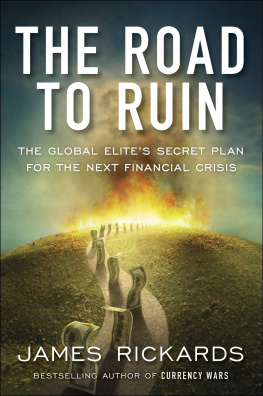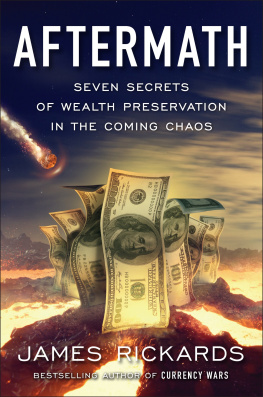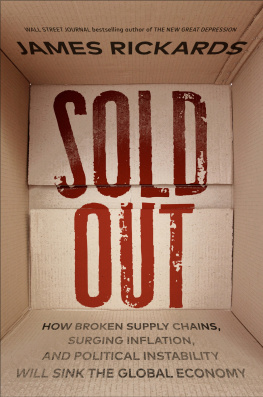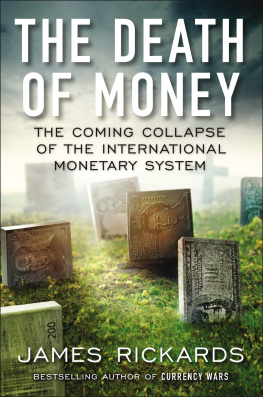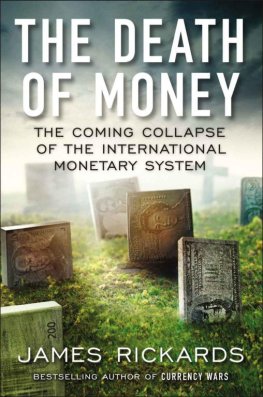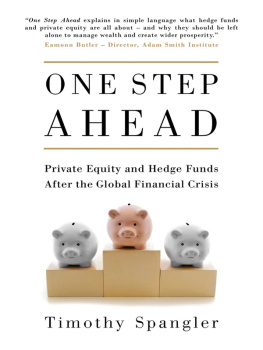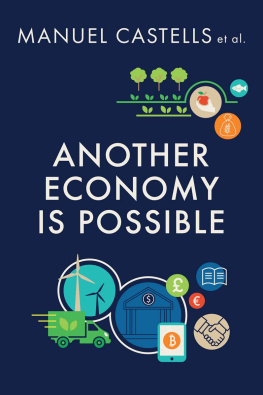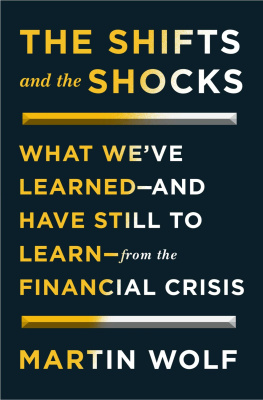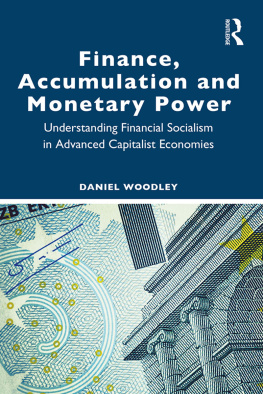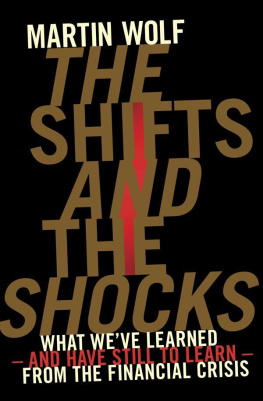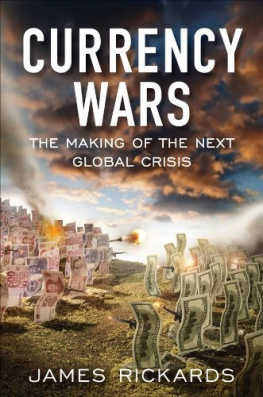ALSO BY JAMES RICKARDS
Currency Wars
The Death of Money
The New Case for Gold
James Rickards
THE ROAD TO RUIN
The Global Elites Secret Plan for the Next Financial Crisis
PORTFOLIO PENGUIN
UK | USA | Canada | Ireland | Australia
India | New Zealand | South Africa
Portfolio Penguin is part of the Penguin Random House group of companies whose addresses can be found at global.penguinrandomhouse.com
First published in the United States of America by Portfolio/Penguin, an imprint of Penguin Random House LLC 2016
First published in Great Britain by Portfolio 2016
Copyright James Rickards, 2016
The moral right of the author has been asserted
Cover art: C. J. Burton
ISBN: 978-0-241-97255-7
THE ROAD TO RUIN
James Rickards is the New York Times bestselling author of The Death of Money, Currency Wars and The New Case for Gold, which have been translated into fourteen languages. He is the editor of the newsletter Strategic Intelligence and is a member of the advisory board of the Centre for Financial Economics at Johns Hopkins University. An adviser on international economics and financial threats to the Department of Defence and the US intelligence community, he served as a facilitator of the first-ever financial war games conducted by the Pentagon. He lives in Connecticut. Follow @JamesGRickards.
To the memory of John H. Makin, economist, mentor, and friend. We need him now more than ever.
When he had opened the third seal, I heard the third living creature cry out, Come forward. And I beheld a black horse, and its rider held a scale in his hand. I heard a voice in the midst of the four living creatures. It said, A measure of wheat costs a days pay, and three measures of barley cost a days pay. But do not damage the oil and the wine.
Revelation 6:56
Introduction
Felix Somary was perhaps the greatest economist of the twentieth century. He is certainly among the least known.
Somary was born in 1881 in a German-speaking part of what was then the Austro-Hungarian Empire. He studied law and economics at the University of Vienna. There he was a classmate of Joseph Schumpeters and took his Ph.D. with Carl Menger, the father of Austrian economics.
During the First World War Somary served as a central banker in occupied Belgium, but for most of his career he was a private banker to wealthy individuals and institutions. He moved to Zurich in the 1930s where he lived and worked until his death in 1956. Somary spent most of the Second World War in Washington, D.C., where he served as a Swiss envoy on financial affairs and provided advice on finance to the War Department.
Somary was widely considered the worlds greatest expert on currencies. He was frequently called upon by central banks to advise on monetary policy. Unfortunately for those banks, his sound advice was mostly ignored for political reasons.
He was called the Raven of Zurich for his uncanny ability to foresee financial catastrophes when others were complacent. Ravens in Greek mythology are associated with Apollo, god of prophecy. In the Old Testament book of Kings, ravens are commanded by God to minister to the prophet Elijah. Somary was perhaps the greatest economic prophet is titled The Raven of Zurich.
Somary not only foresaw the First World War, the Great Depression, and the Second World War before others, but he accurately warned about the deflationary and inflationary consequences of those cataclysms. He lived through the demise of the classical gold standard, the currency chaos of the interwar period, and the new Bretton Woods system. He died in 1956 before the Bretton Woods era came to an end.
Somarys success at forecasting extreme events was based on analytic methods similar to ones used in this book. He did not use the same names we use today; complexity theory and behavioral economics were still far in the future when he was engaged with markets. Still, his methods are visible from his writings.
in his memoir called The Sanjak Railway, which describes an episode that occurred in 1908 involving Somarys efforts to syndicate a commercial loan. The loan proceeds were to build a railroad from Bosnia to the Greek port city of Salonika, todays Thessaloniki. The railroad itself was an insignificant project. Somary was engaged by backers in Vienna to report on its financial feasibility.
The proposed route crossed an Ottoman province called the Sanjak of Novi Bazar. This route necessitated an application from Vienna to the Sublime Porte for permission.
What happened next shocked Vienna. Foreign ministries from Moscow to Paris protested vehemently. As Somary writes, to Austria-Hungarys application for a rail concession with a storm of protest unparalleled in intensityand had in turn made a political countermove by proposing a railway from the Danube to the Adriatic.
This railroad incident took place before the Balkan Wars of 191213, and six years before the outbreak of the First World War. Yet, based on the French-Russian reaction alone, Somary correctly inferred that world war was inevitable. His analysis was that if an insignificant matter excited geopolitical tensions to the boiling point, then larger matters, which inevitably occur, must lead to war.
This inference is a perfect example of Bayesian statistics. Somary, in effect, started with a hypothesis about the probability of world war, which in the absence of any information is weighted fifty-fifty. As incidents like the sanjak railway emerge, they are added to the numerator and denominator of the mathematical form of Bayes theorem, increasing the odds of war. Contemporary intelligence analysts call these events indications and warnings. At some point, the strength of the hypothesis makes war seems inevitable. Bayes theorem allows an analyst to reach that conclusion ahead of the crowd.
The sanjak railway episode echoes rivalries in our own day about natural gas pipelines from the Caspian Sea to Europe, some of which may traverse old Ottoman sanjaks. The playersTurkey, Russia, and Germanyare the same. Where is our new Somary? Who is the new raven?
Somary also used the historical-cultural method favored by Joseph Schumpeter. In 1913, Somary was asked by the seven great powers of the day to reorganize the Chinese monetary system. He declined the role because he felt a more pressing monetary crisis was coming in Europe. A decade ahead of a powerful deflation that held the world in its grip from 1924 to 1939, he wrote:
for their rejection of paper money and their practice of weighing metallic currency on scales. People presumed that the Chinese were five generations behind usin reality they were a generation ahead of Europe. Under the Mongol emperors they had experienced a boom in which paper billions were issued to finance military conquests and vast public works, only to go through the bitter deflationary consequencesand the impression of all this had lasted through many subsequent centuries.
Somary also showed his mastery of behavioral psychology in analyzing an incident from July 1914, in which King George V of England assured the kaisers brother, who was the kings cousin, that war between England and Germany was impossible:
to his cousin, but I was uncertain how much insight the King could have into the situation. I had seen six years before how little informed more capable rulers had been; the information available to insiders, and precisely the most highly placed among them, is all too often misleading. I relied more the on the judgment of

